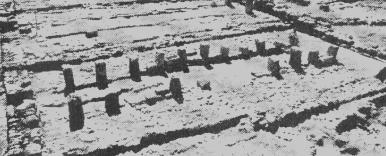 Solomon's
Gold Solomon's
Gold
 In
1939, Shishak's mummy was found in a gold covered sarcophagus, possibly
some In
1939, Shishak's mummy was found in a gold covered sarcophagus, possibly
some
of the gold he had
taken from Solomon. (I Kings 14:25,26).
|
 Solomon's
Stables Solomon's
Stables
 His
horses are mentioned in I Kings 9:19 and 10:26-29. The Oriental Institute His
horses are mentioned in I Kings 9:19 and 10:26-29. The Oriental Institute
uncovered, in Megiddo,
the ruins of Solomon's stables, with their stone hitching poles
and mangers. Nearby
was a foundation stone of a house occupied by one of
Solomon's army officers
inscribed "Shield of David".
 Solomon's
stables Solomon's
stables
|
 Solomon's
Navy Solomon's
Navy
 In
1938-1939, Dr. Glueck identified the ruins of Ezion-geber, and found smelters, In
1938-1939, Dr. Glueck identified the ruins of Ezion-geber, and found smelters,
furnaces, crucibles
and refineries, of Solomon's time. (I Kings 9:26)
|
 Solomon's
Building Stones Solomon's
Building Stones
 (I
Kings 7:9-12), Many of these stones are still in place. In 1852, Barkley
discovered (I
Kings 7:9-12), Many of these stones are still in place. In 1852, Barkley
discovered
the quarry from which
they came.
|
 Omri
Built Samaria Omri
Built Samaria
 A
Harvard University Expedition uncovered the ruins of Omri's palace in Samaria,
with A
Harvard University Expedition uncovered the ruins of Omri's palace in Samaria,
with
no relics older than
the time of Omri, evidence that he was founder of the city. (I Kings
16:24)
|
 Re-Building
of Jericho Re-Building
of Jericho
 Jericho
was destroyed by Joshua about 1400 B.C.. Joshua predicted
that whoever Jericho
was destroyed by Joshua about 1400 B.C.. Joshua predicted
that whoever
attempted to rebuild
it would, in the effort, lose his first-born and youngest sons. 500
years later Hiel rebuilt
it, losing his first-born and youngest son. It's ruins show that it
was uninhabited from
14th to 9th centuries B.C. A jar with the remains
of a child was
found in the masonry
of a gate; and two such jars in the walls of a house. (I Kings
16:34; Joshua 6:26;
I Kings 16:34)
|
 Elijah
and the Prophets of Baal Elijah
and the Prophets of Baal
 In
the ruins of Megiddo, The Oriental Institute found, in the stratum of Elijah's
time, In
the ruins of Megiddo, The Oriental Institute found, in the stratum of Elijah's
time,
many jars containing
the remains of infants who had been slain in sacrifice to Baal.
Prophets of Baal were
official legalized murderers of little children. This helps us to
understand why Elijah
slew these prophets.
|
 |
|
Ahab's House of Ivory,
Mohab's Rebellion, Hazeal's Succession, Jehu's Tribute to Assyria
|
 |
 Ahab's
House of Ivory Ahab's
House of Ivory
 A
Harvard University Expedition found in Samaria, the ruins of this "ivory"
palace, with A
Harvard University Expedition found in Samaria, the ruins of this "ivory"
palace, with
thousands of pieces
of the most exquisitely carved ivory, just above the ruins of Omri's
palace. (I Kings 22:39)
|
 Mohab's
Rebellion Against Israel Mohab's
Rebellion Against Israel
 In
1868, at Dibon, in Moab, the Moabite King's own account of this rebellion
was In
1868, at Dibon, in Moab, the Moabite King's own account of this rebellion
was
found. It is called
the "Moabite Stone". (II Kings 3:4,5)
|
 Hazeal's
Succession Hazeal's
Succession
 An
Assyrian inscription found tells of Hazeal's Succession to Benhadad's Throne. An
Assyrian inscription found tells of Hazeal's Succession to Benhadad's Throne.
(II Kings 8:15).
|
 Jehu's
Tribute to Assyria Jehu's
Tribute to Assyria
 The
"Black Obelisk", a block of black stone, 7 feet high, covered with reliefs
and The
"Black Obelisk", a block of black stone, 7 feet high, covered with reliefs
and
inscriptions, depicting
the exploits of Jehu, supplies additional information of Jehu
paying tribute to the
Assyrian king. (II Kings 10:32-34)
|
 |
| Jezebel's Make-up Saucer,
Seal of Jeroboam's Servant, Menahem Paid Tribute to Pul, Uzziah, Ahaz,
Menahem, Pekah, Hoshea, Hoshea
Slew
Pekah
|
 |
 Jezebel's
Make-up Saucer Jezebel's
Make-up Saucer
 In
Syria, the actual saucers in which Jezebel mixed her cosmetics was found,
in the In
Syria, the actual saucers in which Jezebel mixed her cosmetics was found,
in the
ruins of Ahab's "Ivory
House". Small stone boxes, with a number of holes for various
colors: kohl for black,
turquoise for green, ochre for red: with a central depression for
mixing. They still
had traces of red. (II Kings 9:30)
|
 Seal
of Jeroboam's Servant Seal
of Jeroboam's Servant
 (II
Kings 14:23-29) A seal was found among the ruins of Megiddo, inscribed, (II
Kings 14:23-29) A seal was found among the ruins of Megiddo, inscribed,
"Belonging to Shema
the servant of Jeroboam".
|
 Menahem
Paid Tribute to Pul Menahem
Paid Tribute to Pul
 (II
Kings 15:19,20) One of Pul's inscriptions found says, "Tribute of Menahem
of (II
Kings 15:19,20) One of Pul's inscriptions found says, "Tribute of Menahem
of
Samaria, Rezin of Damascus,
Hiram of Tyre, I received".
|
 Uzziah,
Ahaz, Menahem, Pekah, Hoshea Uzziah,
Ahaz, Menahem, Pekah, Hoshea
 These
five kings are named in the inscription of Pul, king of Assyria These
five kings are named in the inscription of Pul, king of Assyria
|
 Hoshea
Slew Pekah Hoshea
Slew Pekah
 (II
Kings 15:30; 17:3) An inscription of Tiglath-pileser says, "Pekah their
king they had (II
Kings 15:30; 17:3) An inscription of Tiglath-pileser says, "Pekah their
king they had
overthrown. I placed
Hoshea over them. From him I received 10 talents of gold and
1000 talents of silver."
|




